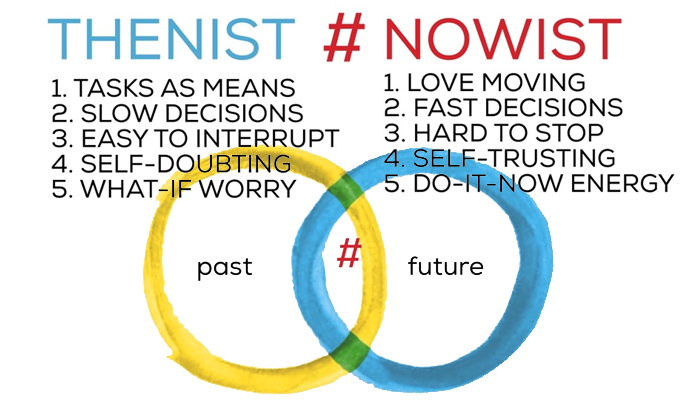My new book, #NOW, argues that we are all at least a little bit Nowist. We can all enjoy movement and taking action. But how Nowist or Thenist are you? And how well is it working for you?
Being Nowist is not just a fixed personality trait or ability. It is a flexible mindset that can be developed to provide forward motion.
We all live between the past and the future. We live in the present, and we can only directly think, do or change anything at the point of #Now.
In the book, the past and present are represented by two circles, with the intersection represented by #. Its where you shape your future, and where you experience the one billion moments that make up your life.
There are important, and valuable, differences between the two mindsets. And at work or at home, it can be useful to understand those differences.

We have all these two incredibly powerful useful abilities we all have. Our Nowist mindset. The ability and desire to take action and keep moving. And our Thenist mindset, our amazing ability to imagine the past and the future.
They can work wonderfully together, or they can cause problems when those parts of our brains are no longer in harmony. They can sabotage us, or help us to live happier, more enjoyable lives.
First: When you feel like a Thenist, tasks are a means to an end. You do things to look good or to get the task finished. You might forget to enjoy life. Nowists love moving, and seek joy in doing things. They donít want to waste their lives waiting for happiness, so they seek happiness now.
Second: Thenists are more likely to agonise about decisions. This can slow them down, they can procrastinate, or they can suddenly lurch into a decision that makes no sense. They can get stuck in a downwards spiral. Nowists make effortless, rapid or fast decisions. They see sequences, and they have a sense of where they are going.
Third: When in a Thenist mindset you can be easy to interrupt or slow down. Even distant worries can derail you, and leave you in a downwards spiral of inactivity and anticipated regret. You can work hard, but it feels like hard work, leaving you worn-out and overwhelmed. But when youíre in a Nowist mindset, you can be hard to stop. You feel like a force of nature with almost limitless energy to keep moving forward. You see obstacles as opportunities, and stress as just another source of forward motion.
Fourth: Thenists tend to be self-doubting. They may second-guess their own judgement, even when they know they are factually right. Nowists tend to be self-trusting. They are confident in their abilities in general, and in particular their abilities to improve and learn. They develop a sense of personal power, not over others but to make good things happen. They test their ability and learn more about cause, effect. They also learn more about the meaning and value of their actions and outcomes.
Fifth: In a Thenist mindset, your energy can be wasted on worry, on going nowhere except self-defeating or passive directions. The worry steals from your positive present. In a Nowist mindset you have do-it energy. You invest time or energy in things you can change. And when you do start to worry, you quickly recognise the downwards spiral. You roll out of negativity and move forwards.
Super-Nowists are those people who become extraordinarily good at everything that weíve discussed in the book. They move forward at breath-taking speed. They have a stunningly clear idea of how things work, what they want and where they are going. They accomplish most, and love both the journey and the destination.
Some of them are famous super-tasking, ground-breaking polymaths. Others bring an unusual calmness to demanding situations. But they all demonstrate a remarkable capacity to grow to meet any stress or setback, and donít need the prospect of headlines or awards to motivate them.
You may not be a Super-Nowist, or even want to be, but thereís much to be learned from them about how to enjoy your #Now. We can all be a little more Nowist!

